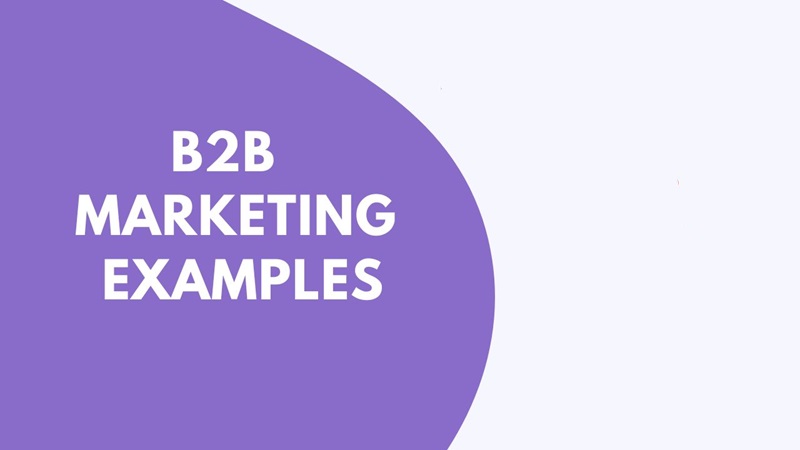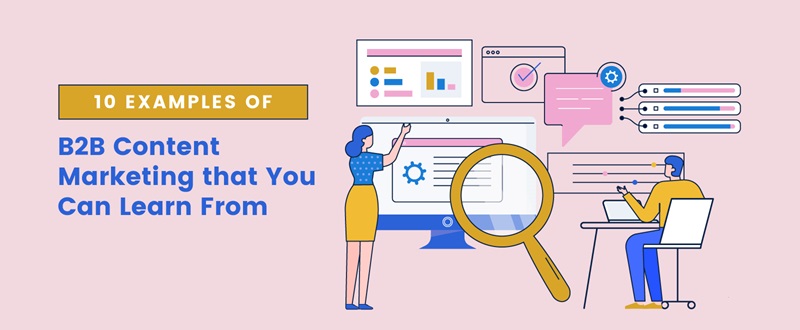Content marketing is a crucial aspect of any B2B strategy, as it allows businesses to establish their expertise and build trust with potential clients. There are countless examples of B2B content marketing done right, but here are 10 particularly awesome ones that stand out. One great example is Adobe’s CMO.com, a website dedicated to providing valuable insights and resources for marketing professionals. Another standout is GE’s «GE Reports» blog, which showcases the company’s innovative technology and solutions in a compelling and engaging way.
HubSpot’s «Marketing Resources» section is also a fantastic example of B2B content marketing, offering a wealth of helpful guides, templates, and tools for marketers. Cisco’s «The Network» is another great example, providing thought leadership content on all things technology and networking. IBM’s «Think» blog is yet another standout, offering in-depth analysis and commentary on the latest trends in business and technology. LinkedIn’s «Marketing Solutions Blog» is also a fantastic resource for B2B marketers, offering valuable tips and insights on how to leverage the platform for business success.
Salesforce’s «Salesforce Blog» is another great example, providing valuable content on sales, marketing, and customer service. Slack’s «Slack Platform Blog» showcases the company’s commitment to innovation and collaboration, offering insights on how businesses can leverage the platform for success. Lastly, SAP’s «Digitalist Magazine» is a must-read for B2B marketers, offering cutting-edge insights on digital transformation and business strategy. Overall, these 10 examples of awesome B2B content marketing showcase the power of creating valuable, engaging content to drive business success.
Zapier has utilized listicles as a powerful tool to drive traffic to their website, resulting in over 5 million sessions. Listicles are a popular format for online content that presents information in a concise and easy-to-digest manner. By creating listicles that provide valuable insights, tips, and resources related to their target audience, Zapier has been able to attract a large number of visitors to their site. These listicles cover a wide range of topics, from productivity hacks to software recommendations, making them appealing to a diverse group of readers.
By consistently producing high-quality listicles that address the needs and interests of their audience, Zapier has been able to establish themselves as a go-to resource for information and advice in the tech industry. The use of listicles has allowed Zapier to effectively engage with their audience, drive traffic to their website, and ultimately increase their brand visibility and credibility. Additionally, listicles are highly shareable content that can easily be distributed across social media platforms, further expanding Zapier’s reach and attracting new visitors to their site. In conclusion, Zapier’s strategic use of listicles has proven to be a successful method for generating traffic and establishing themselves as a leading authority in the tech industry.

Aira’s 2021 Link Building Report provides valuable insights into the current landscape of link building strategies and trends. The report highlights the importance of building high-quality, relevant backlinks to improve search engine rankings and drive organic traffic to websites. One key finding from the report is the increasing emphasis on creating content that naturally attracts links from reputable websites, rather than relying on manipulative tactics such as buying links or participating in link schemes.
This shift towards more authentic and organic link building practices reflects a growing awareness of the importance of building sustainable, long-term relationships with other websites in order to establish credibility and authority in the eyes of search engines.
Additionally, the report emphasizes the importance of diversifying link building efforts across a variety of sources, including guest blogging, resource pages, and social media platforms, to ensure a well-rounded and robust backlink profile. Overall, Aira’s 2021 Link Building Report underscores the significance of adopting ethical and effective link building strategies in order to achieve sustainable success in the competitive online marketplace.
Keyword research is a critical aspect of any successful SEO strategy, as it helps businesses understand what their target audience is searching for online. However, simply identifying high-volume keywords is not enough to drive organic traffic to your website. To truly enhance your keyword research efforts, it is important to also consider search intent analysis.
Search intent refers to the reason behind a user’s search query, and understanding this can help you create content that aligns with their needs and interests. By analyzing search intent, you can ensure that the keywords you target not only drive traffic to your site but also attract visitors who are likely to engage with your content.
For example, if a user is searching for «best hiking trails,» their intent is likely informational, indicating that they are looking for recommendations and tips. By incorporating this insight into your keyword research, you can create content that addresses their specific query, increasing the likelihood of ranking higher in search results and attracting qualified leads.
In addition, understanding search intent can also help you uncover valuable long-tail keywords that may have less competition but are highly relevant to your target audience. By combining keyword research with search intent analysis, businesses can optimize their content strategy to better meet the needs of their audience and drive organic traffic to their website.

Performance advertising is a marketing strategy that focuses on driving specific actions or behaviors from consumers, such as clicking on an ad, making a purchase, or signing up for a newsletter. While this type of advertising can be highly effective in driving results and measuring return on investment, there are potential misconceptions that need to be examined.
One common misconception is that performance advertising is a one-size-fits-all solution that guarantees success. In reality, the effectiveness of performance advertising can vary depending on the target audience, the quality of the ad creative, and the overall marketing strategy.
Another misconception is that performance advertising is a set-it-and-forget-it tactic that requires little to no ongoing optimization or monitoring. In truth, successful performance advertising campaigns require constant monitoring, testing, and optimization to ensure that they are delivering the desired results. Additionally, some may mistakenly believe that performance advertising is a quick fix for all marketing challenges, when in fact it is just one piece of the larger marketing puzzle. By examining these potential misconceptions and taking a more nuanced approach to performance advertising, marketers can maximize the effectiveness of their campaigns and drive better results for their brands.
Content marketing is a powerful tool for businesses looking to connect with their target audience and drive engagement. In 2022, staying informed about the latest content marketing statistics is crucial for developing successful strategies. Some key statistics to keep in mind include the fact that 70% of consumers prefer to learn about a company through articles rather than advertisements. Additionally, 84% of people expect brands to create content that entertains, provides solutions, and produces experiences and events.
Video content is also on the rise, with 54% of consumers wanting to see more video content from brands they support. When it comes to social media, 90% of consumers say authenticity is important when deciding which brands they like and support. In terms of search engine optimization, companies that blog receive 97% more links to their website. Email marketing remains a valuable tool, with 59% of marketers saying email is their biggest source of ROI.
Furthermore, personalized email campaigns have a 26% higher open rate. Finally, 91% of B2B marketers use content marketing to reach customers. By staying up-to-date on these essential content marketing statistics, businesses can tailor their strategies to effectively engage with their audience and drive success in 2022.
High-performing content on Google Discover typically possesses key traits that set it apart from the rest. One of the most important traits is relevance. Content that is highly relevant to the user’s interests and preferences is more likely to be featured on Google Discover and receive high levels of engagement. Another key trait is quality.
Content that is well-written, visually appealing, and informative is more likely to be favored by Google’s algorithm and recommended to users. Additionally, high-performing content often incorporates a variety of media types, such as images, videos, and interactive elements, to keep users engaged and interested.
Consistency is also a crucial trait of successful content on Google Discover. Content creators who regularly publish high-quality, relevant content are more likely to build a loyal following and see their content featured on the platform. Finally, high-performing content tends to be optimized for mobile devices, as the majority of Google Discover users access the platform on their smartphones.
By ensuring that content is easy to read and navigate on mobile, content creators can increase their chances of reaching a wider audience and achieving success on Google Discover. Overall, content that is relevant, high-quality, engaging, consistent, and mobile-friendly is more likely to perform well on Google Discover and attract a larger audience.
As we look towards the year 2021, Gartner has identified several key security and risk trends that organizations need to be aware of in order to protect their data and systems. One major trend is the increasing use of artificial intelligence and machine learning in cybersecurity. These technologies have the potential to greatly enhance organizations’ ability to detect and respond to threats in real-time, helping them stay one step ahead of cybercriminals.
Another important trend is the continued rise of remote work, which brings with it a host of security challenges. As more employees work from home, organizations need to ensure that their networks and devices are secure, and that employees are trained in best practices for keeping data safe.
Additionally, Gartner predicts that ransomware attacks will continue to increase in frequency and sophistication, posing a significant threat to organizations of all sizes. To combat this trend, organizations need to invest in robust backup and recovery solutions, as well as employee training to recognize and report suspicious activity.
Overall, the key takeaway from Gartner’s top security and risk trends for 2021 is the need for organizations to stay vigilant and proactive in their approach to cybersecurity, leveraging the latest technologies and best practices to protect their valuable data and assets from evolving threats.

Methodology refers to the systematic approach or set of procedures used to conduct research or achieve a specific goal. It is a structured and organized way of gathering information, analyzing data, and drawing conclusions. In the field of research, methodology is crucial as it provides a framework for researchers to follow in order to ensure the validity and reliability of their findings.
It involves the selection of research methods, data collection techniques, and data analysis procedures that are most appropriate for the research question being investigated. The methodology used in a study can greatly impact the outcome and credibility of the results.
In other contexts, such as business or project management, methodology can refer to a set of guidelines or best practices that are used to achieve specific objectives or outcomes. Having a well-defined methodology can help organizations streamline processes, improve efficiency, and achieve success in their endeavors.
Ultimately, methodology is about having a clear and systematic approach to problem-solving or decision-making that can lead to more effective and informed outcomes. It provides a structured framework for addressing challenges and achieving goals in a methodical and strategic manner. By following a sound methodology, individuals and organizations can make more informed decisions, improve their performance, and achieve their desired outcomes.
B2B content marketing strategies and themes are essential for businesses looking to attract and engage other businesses as their target audience. Some prominent strategies include creating valuable and informative content that addresses the pain points and challenges faced by B2B customers. This can include whitepapers, case studies, and how-to guides that showcase the business’s expertise and knowledge in the industry. Another key strategy is to personalize content to cater to the specific needs and interests of different B2B customers. This can be achieved through targeted email campaigns, personalized landing pages, and tailored content recommendations.
Additionally, leveraging social media platforms to distribute and promote B2B content can help reach a wider audience and increase brand visibility. Themes such as thought leadership, industry trends, and best practices are also popular among B2B content marketers as they position the business as a trusted authority in the industry. By diving into these prominent B2B content marketing strategies and themes, businesses can effectively engage with their target audience, drive traffic to their website, and ultimately generate more leads and conversions.
Engaging examples of B2B content are key in capturing the attention and interest of potential business clients. One effective way to do this is through storytelling. By sharing real-life examples of how a product or service has helped a business overcome a challenge or achieve success, companies can showcase the benefits of their offerings in a relatable and compelling way. Another engaging approach is to create interactive content such as quizzes, assessments, or calculators that allow potential clients to actively engage with the content and see the value of the product or service firsthand.
Additionally, incorporating multimedia elements such as videos, infographics, or podcasts can help to make the content more visually appealing and easier to digest. By providing valuable and informative content that addresses the needs and pain points of their target audience, B2B companies can establish themselves as trusted experts in their industry and build credibility with potential clients. Ultimately, engaging B2B content is essential in driving customer engagement, building brand awareness, and ultimately converting leads into loyal customers.